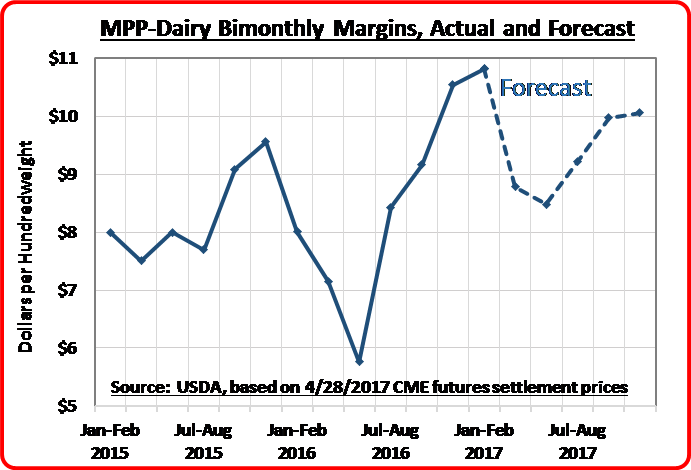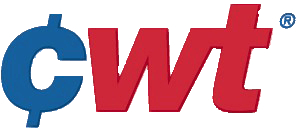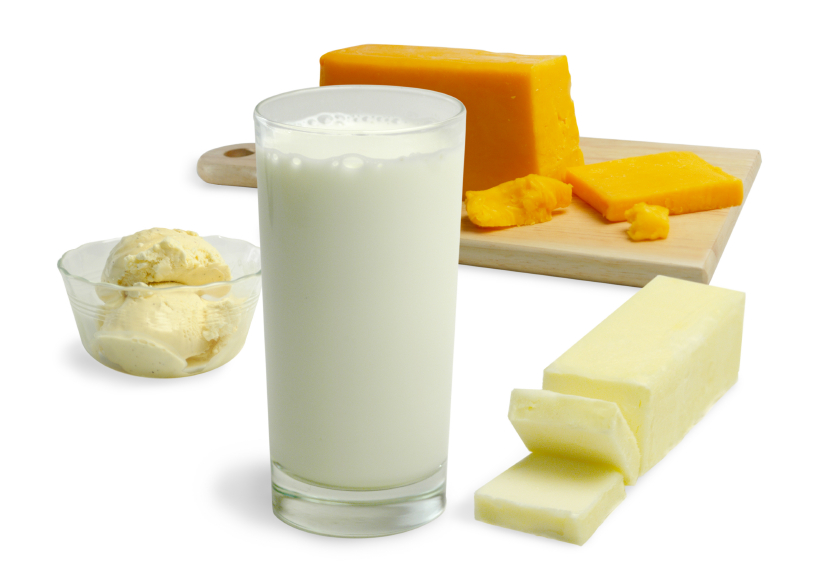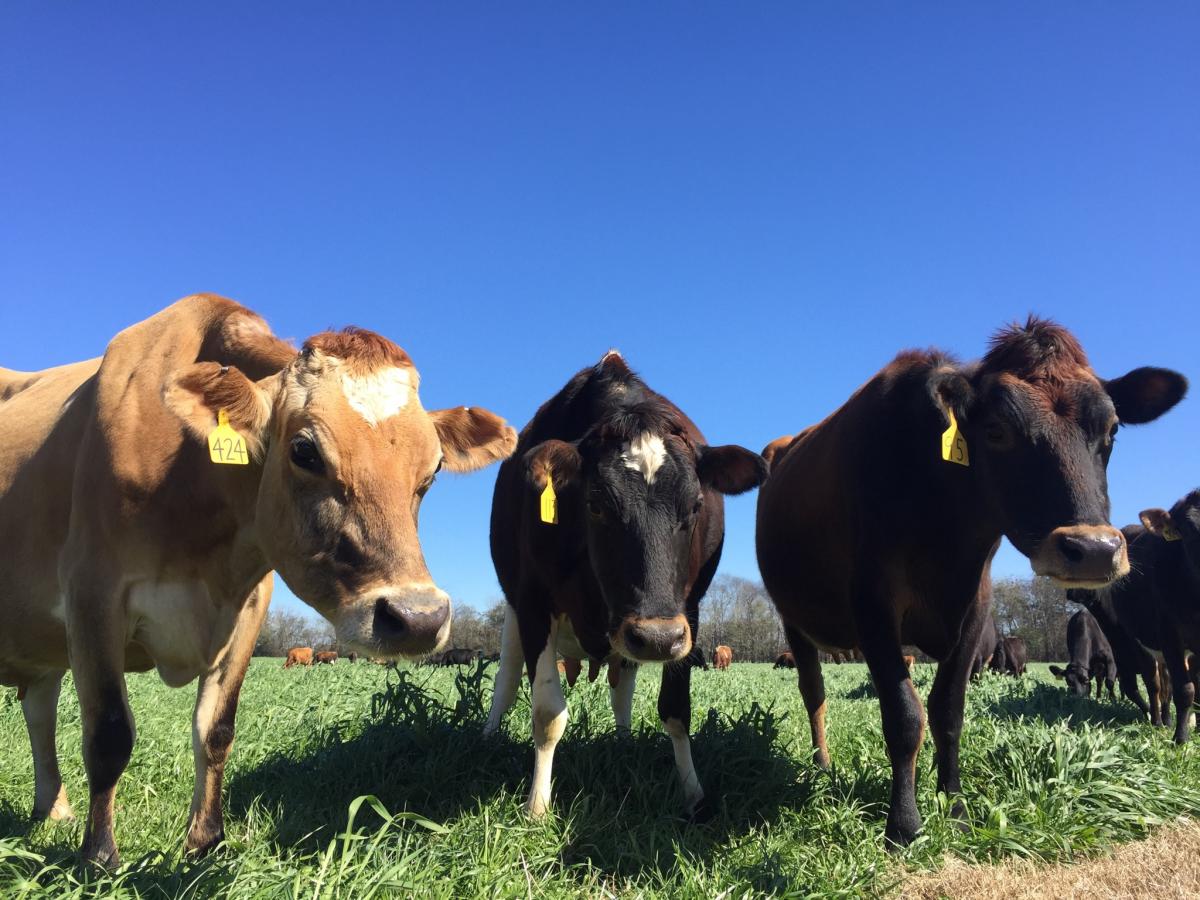President Trump Joins U.S. Dairy Sector, Members of Congress in Criticizing Canada’s Damaging New Pricing Scheme
May 08, 2017 National Milk’s efforts to reverse Canada’s damaging dairy trade policy changes made international news last month when President Donald Trump spoke publicly about how Canada’s trade violations are “a disgrace,” and harm U.S. dairy producers. Farmers and dairy company leaders reinforced this message during high-level meetings with administration officials and Congress members at the beginning of May.
National Milk’s efforts to reverse Canada’s damaging dairy trade policy changes made international news last month when President Donald Trump spoke publicly about how Canada’s trade violations are “a disgrace,” and harm U.S. dairy producers. Farmers and dairy company leaders reinforced this message during high-level meetings with administration officials and Congress members at the beginning of May.
NMPF has been warning since mid-2016 that Canada’s new Class 7 pricing scheme, piloted last year in Ontario as Class 6 and now being used in numerous provinces, gives unfair advantage to domestic milk ingredients in an industry that already benefits tremendously from Canada’s high-cost supply management dairy structure. This new policy has pulled the rug out from under U.S. exports of U.S. ultrafiltered milk, while at the same time undercutting U.S. exports to other global markets.
This national ingredients strategy “has resulted in lost markets for companies in Wisconsin and New York, threatening the livelihoods of numerous dairy farm families,” said Jim Mulhern, president and CEO of NMPF.
Even more worrisome, he said, is that the policy “also enables Canada to dump excess dairy proteins onto world markets, posing a larger and longer-term threat to U.S. dairy farmers relying on overseas milk powder sales.” Reports have already surfaced of Canadian milk powder being offered on global markets at fire sale prices – a new development since the introduction of Class 7.
During a fly-in rally organized NMPF and the U.S. Dairy Export Council (USDEC), more than 30 farmers and dairy company executives fanned out on Capitol Hill to emphasize that trade opportunities both north and south of the U.S. are crucial to America’s dairy sector. The dairy coalition also met with Agriculture Secretary Sonny Perdue, Acting U.S. Trade Representative Stephen Vaughn and White House agriculture advisor Ray Starling (second photo: producers with House Speaker Paul Ryan).
NMPF and other U.S. dairy groups have repeatedly raised concerns about Canada’s efforts to undercut competition from the United States. NMPF has worked to bring this issue to the attention of Trump Administration officials, members of Congress and dozens of governors, most recently in an April 13 letter asking Trump to urge Canadian Prime Minister Justin Trudeau to halt the new pricing policy and restore the flow of U.S. ultrafiltered milk.
These engagement efforts bore fruit in mid-April when, during a speech in Wisconsin, Trump reprimanded Canada for its pricing scheme, calling the resulting impact on U.S. farmers “unfair,” followed by a tweet reiterating this point. Other political leaders, including House Speaker Paul Ryan and Senate Minority Leader Chuck Schumer, have also pressed Canada on the negative impacts of its approach to dairy trade. Both congressional leaders have written to the administration on this issue in the past month.
Other members also chimed in to create a swelling chorus of concern about Canada’s actions. Most recently, a bipartisan group of 68 House members sent a letter in late April to the White House, asking Trump to insist Canada comply with its trade obligations. NMPF worked closely with the offices that led this letter: Reps. Collins, DelBene, Stefanik, Kind, Duffy and Welch.
“Canada has repeatedly sought ways to evade its trade commitments and erode U.S. export gains, both within Canada and around the world,” Mulhern said. “We are pleased to see our efforts to insist that Canada play by the rules are building a broad base of bipartisan awareness about the urgent need to take action on this issue.”
Even as Canada and the future of the North American Free Trade Agreement (NAFTA) have dominated headlines, NMPF has been vocal about the need to preserve the agreement in light of the stable and reliable partnership with Mexico, U.S. dairy’s No. 1 export market. The United States sold $1.2 billion worth of dairy products last year to customers in Mexico, amounting to roughly one-fourth of total U.S. exports. Those exports create tens of thousands of U.S. jobs and $3.6 billion in U.S. economic impact.
Mulhern said “NMPF will continue to insist that any renegotiation of NAFTA maintain this vital export market, and preserve the strong working relationship with customers and counterparts in Mexico.”
No MPP Fix in Federal Spending Bill; NMPF to Continue to Seek Opportunities
May 08, 2017NMPF is continuing its efforts to impress upon Congress the urgent need to improve the Margin Protection Program to make it an effective risk management tool for dairy farmers. NMPF has developed and recommended a series of improvements, including changing the feed formula and altering the premium rate structure to make the program more effective and affordable for dairy farmers.
As Congress worked to finalize its annual government spending bill last week, NMPF worked with legislators in an effort to identify funding options to improve MPP in that bill. But that effort, like many other requests, was unable to be included due to budgetary constraints on the overall spending package, which dealt with funding for all federal programs. Cotton interests also sought to address deficiencies in their safety net, but unfortunately, neither was included in the final package approved by Congress this week.
NMPF will continue to work on a bipartisan basis with dairy policy leaders and other members of the House and Senate to identify every possible opportunity for MPP reform and drive home the point that our dairy producers need this safety net to work for them – and that will require resources from Congress.
New Agriculture Secretary Reinstates 1% Flavored Milk in Schools
May 08, 2017 Acknowledging the importance of providing school children with more milk options, Agriculture Secretary Sonny Perdue – in one of his first formal actions – said the USDA will change its regulations to allow school districts to once again offer 1% flavored milk as part of the National School Lunch and School Breakfast programs. NMPF has fought for the return of low-fat flavored milk in schools since the product was removed following passage in 2010 of the Healthy, Hunger-Free Kids Act.
Acknowledging the importance of providing school children with more milk options, Agriculture Secretary Sonny Perdue – in one of his first formal actions – said the USDA will change its regulations to allow school districts to once again offer 1% flavored milk as part of the National School Lunch and School Breakfast programs. NMPF has fought for the return of low-fat flavored milk in schools since the product was removed following passage in 2010 of the Healthy, Hunger-Free Kids Act.
Since the USDA regulations implementing the act limited milk options in the school meal and a la carte programs to nonfat flavored milk and low-fat white milk, consumption of school milk declined, as has overall participation in the school lunch program.
NMPF thanked Perdue for recognizing the role of healthy dairy foods in childhood nutrition.
“In just the first two years after low-fat flavored milk was removed from schools, 1.1 million fewer students drank milk with their lunch,” said Jim Mulhern, president and CEO of NMPF. “Secretary Perdue’s action recognizes that a variety of milks and other healthy dairy foods are integral to child nutrition programs in schools.”
Perdue’s announcement at a school in Leesburg, Virginia, came less than a week after his Senate confirmation. National Milk pledged to work with Perdue on nutrition and health issues, along with other economic and policy challenges facing U.S. dairy producers, including improvements to the Margin Protection Program (MPP) and immigration policy.
During his confirmation hearing last month, Perdue said he wants to improve the MPP, and is open to creating additional risk management coverage for milk through USDA’s Risk Management Agency.
Regarding immigration reform, Perdue told the Senate Agriculture Committee that he would explore an exemption to the H-2A program so dairy farms can hire workers for year-round labor. The current seasonal H-2A visa does not apply to dairy farms because of their perennial need for farm labor.
NMPF Concerns about Loss of Common Cheese Names Reflected in New U.S. Government Report
May 08, 2017 NMPF’s campaign to challenge the erosion U.S. cheese makers’ ability to use common food names was reflected in a new report from the Trump Administration cataloguing the potential loss to American businesses caused by European trade policy.
NMPF’s campaign to challenge the erosion U.S. cheese makers’ ability to use common food names was reflected in a new report from the Trump Administration cataloguing the potential loss to American businesses caused by European trade policy.
Last week, the U.S. Trade Representative’s Office (USTR) outlined the Trump Administration’s commitment to curtailing the damaging abuses of geographical indications (GIs) – particularly by the European Union (EU). NMPF joined the Consortium for Common Food Names (CCFN) in hailing the report as a strong, positive signal on how the administration plans to tackle these types of trade and intellectual property issues in the next four years.
The report highlighted ongoing threats to U.S. companies that legally use common food names both within the United States and in global trade. This report is released each year by the USTR’s office, and outlines extensive efforts that the administration is making around the world to stem the EU’s efforts erect barriers to U.S. exports.
Earlier this year NMPF expressed its concerns to USTR about the growing threat to U.S. manufacturers of foods with common names, including cheeses such as parmesan, feta and Asiago. Among NMPF’s specific requests to the USTR: hold trading partners accountable for their commitments; preserve market access negotiated through earlier trade agreements; and prevent competitors from monopolizing widely used generic food terms.
“We cannot allow our trading partners to chip away at the value of prior World Trade Organization or free trade agreement concessions,” said Jim Mulhern, president and CEO of NMPF. “Just because the free trade agreement with Europe is off the table for now doesn’t mean Europe’s dairy sector will sit by. They are aggressively pursuing other trade deals that could limit our export opportunities, and we will continue to be vigilant about challenging those practices”
MPP Forecast: May
May 08, 2017
The USDA’s National Agricultural Statistics Service (NASS) reported that the U.S. average all-milk price dropped $1.20 per hundredweight from February to March, to $17.30 per hundredweight. The price deterioration resulted from declines of more than one dollar per hundredweight in both the Class III and the Class IV federal order prices from February to March. The Class III price has weakened as milk production growth in the past several months has led to increased domestic cheese production and stocks. The Class IV price has weakened as skim milk powder remains oversupplied on world markets.
Feed ingredient prices for March announced by NASS and USDA’s Agricultural Marketing Service showed small and partially offsetting changes from February. These translate into a monthly Margin Protection Program (MPP) feed cost of $7.95 per hundredweight, up $0.03 from February. That slight increase, coupled with the decline in the milk price, generated a MPP margin for March of $9.35 per hundredweight, down $1.23 per hundredweight from February.
USDA’s current MPP margin forecast, based on early May CME futures settlements, projects the margin will remain above $8 per hundredweight during 2017. However, USDA currently projects a slight probability that the margin will fall below the $8 coverage level during May-June, with lower probabilities that this level will trigger MPP payments during other bimonthly periods this year.
USDA’s MPP margin forecasts are updated daily online. NMPF’s Future for Dairy website offers a variety of educational resources to help farmers make better use of the program.
CWT Member Co-ops Capture 6.2 Million Pounds of Export Sales in April
May 08, 2017 Cooperatives Working Together (CWT) assisted member cooperatives in securing 40 contracts to sell 6.2 million pounds of cheese to customers in Asia, Central America, the Middle East and Oceania in April 2017. The product will be shipped from April through July 2017.
Cooperatives Working Together (CWT) assisted member cooperatives in securing 40 contracts to sell 6.2 million pounds of cheese to customers in Asia, Central America, the Middle East and Oceania in April 2017. The product will be shipped from April through July 2017.
Adding these transactions to the other sales made so far this year raises the total CWT-assisted product sales to 29.7 million pounds of cheese and 1.4 million pounds of butter. These sales are destined for customers in 14 countries in five regions, and will move overseas the equivalent of 306 million pounds of milk, on a milkfat basis, in the first seven months of 2017.
Helping CWT member cooperatives gain and maintain world market share through the Export Assistance program in the long-term expands the demand for U.S. dairy products and the U.S. farm milk that produces them. This, in turn, positively impacts all U.S. dairy farmers by strengthening and maintaining the value of dairy products that directly impact their milk price.
The amounts of dairy products and related milk volumes reflect current contracts for delivery, not completed export volumes. CWT will pay export assistance to the bidders only when export and delivery of the product is verified by the submission of the required documentation.
All cooperatives and dairy farmers are encouraged to add their support to this important program. Membership forms are available on the CWT website.
NMPF Works with Dairy Farmers to Voice Their Support of DAIRY PRIDE Legislation
May 08, 2017 Dairy farmers in April continued to speak out in support of the DAIRY PRIDE Act (DPA), legislation that would prompt the U.S. Food and Drug Administration (FDA) to enforce its own law stating that any food product using the term “milk” on its label must come from an animal source, not a plant.
Dairy farmers in April continued to speak out in support of the DAIRY PRIDE Act (DPA), legislation that would prompt the U.S. Food and Drug Administration (FDA) to enforce its own law stating that any food product using the term “milk” on its label must come from an animal source, not a plant.
In April, two Virginia dairy farmers submitted op-ed columns to prominent local newspapers explaining their support of the DPA and why their elected officials should back the bill. Matt Nuckols (right), of Beaverdam, Va., wrote in the Richmond Times-Dispatch that is it unfair for FDA to ignore its own food labeling laws when dairy producers strictly follow government regulations to produce a safe, healthy food.
“We ask that these agencies honor their side of the deal, and enforce the rules for other ‘milk’ makers, too,” Nuckols said. He indicated that government regulators should not be able to pick and choose which policies to enforce, any more than farmers should be able to.
Mark Sowers (left), of Floyd, Va., used his column in the Roanoke Times to note the importance of DPA for Virginia’s 1,000 dairy operations and the state’s robust agriculture sector.
“In 2014, milk was the state’s third-most profitable agricultural product, bringing in $478 million from over 1,000 operations,” he said. “Virginia’s reputation as a strong agriculture state is too great to risk the invasion of these imitators.”
Earlier in April, Sen. Angus King (I-ME) announced his support for the DPA, following another column from Maine dairy farmer Travis Fogler in the state’s largest newspaper, the Portland Press-Herald. To date, the DPA has been backed by the following senators and congresspersons: King, Tammy Baldwin (D-WI), Debbie Stabenow (D-MI) and Jim Risch (R-ID) in the Senate; and Reps. Peter Welch (D-VT), Mike Simpson (R-ID), Sean Duffy (R-WI), Joe Courtney (D-CT), David Valadao (R-CA), Susan DelBene (D-WA), Collin Peterson (D-MN), Mike Gallagher (R-WI), Glenn Grothman (R-WI), Ron Kind (D-WI), Thomas Rooney (R-FL), James Sensenbrenner (R-WI), Richard Nolan (D-MN) and Elise Stefanik (R-NY) in the House.
NMPF continues to publicize legislative action alerts, news articles, infographics and other materials that inform and encourage support for DPA. NMPF strongly encourages cooperatives to share these materials with staff, producer-members and on social media to whip up industry and congressional support.
NMPF Argues that Dairy Products Should be Defined as “Healthy”
May 08, 2017 Dairy products should be labeled as “healthy” and the government should recognize new science that shows the benefits of dairy at all fat levels, NMPF told the U.S. Food and Drug Administration (FDA) last month as the agency takes input from industry groups about food labeling terminology.
Dairy products should be labeled as “healthy” and the government should recognize new science that shows the benefits of dairy at all fat levels, NMPF told the U.S. Food and Drug Administration (FDA) last month as the agency takes input from industry groups about food labeling terminology.
NMPF told the FDA that dairy should be included in a separate category for “healthy” claims, similar to fruits and vegetables. National Milk also said FDA should disregard criteria on total fat and saturated fat in recognition that dairy foods are nutrient-dense and part of three different eating patterns that the Dietary Guidelines for Americans (DGA) defines as “healthy.” The comments noted that the DGA recommends more dairy consumption.
FDA has long enforced rules about which foods can bear the term “healthy” and similar claims on their packaging. NMPF said that because of new scientific evidence, dairy foods considered “healthy” should not be limited to low-fat and fat-free varieties, but also include reduced-fat varieties. NMPF also advised FDA to be flexible in changing “healthy” guidelines so the agency could later add full-fat dairy products as scientific understanding progresses about the benefits of dairy fat in the diet.
Along with other groups, NMPF said FDA should better align its criteria with authoritative dietary guidance, including the DGA. Food identified as “under-consumed” by the DGA should automatically be able to make a “healthy” claim, NMPF said.
FDA Issues PMO Waiver Sought by NMPF for Sanitary Transportation Act
May 08, 2017In early April, the U.S. Food and Drug Administration (FDA) announced three waivers to the final Sanitary Transportation rule mandated by the Food Safety Modernization Act (FSMA), including the Pasteurized Milk Ordinance (PMO) waiver long sought by NMPF.
NMPF has advocated for several years for a waiver for PMO-regulated facilities. When the initial Sanitary Transportation of Human and Animal Food rule was proposed, FDA said it intended to waive the rule’s requirements in certain cases “in which they would not be needed to further protect foods from becoming unsafe.”
The waiver, to be issued soon, applies to inbound raw milk, outbound shipments of milk and cream, and shipments of finished Grade “A” milk products from PMO-regulated facilities.
As part of the regulatory process, NMPF asked for clarification about the phrase “only when transporting Grade ‘A’ milk and milk products” out of concern that most outbound shipments of finished Grade “A” products do not comprise only Grade “A” products, but include non-Grade “A” products like orange juice or ice tea. Thus, the waiver could be viewed as nullifying an outbound shipment containing both Grade “A” and non-Grade “A” products.
FDA declined to provide any further insight, but NMPF holds that outbound shipments of finished products from a PMO-regulated facility are not subject to the rule, even if the shipment contains non-Grade “A” products. For more information about this rule or the waiver, please contact Clay Detlefsen.
Dairy Farmers May Lose Air Emissions Reporting Exemption
May 08, 2017 An appeals court ruling last month could significantly expand the air emissions reporting requirements imposed on animal agriculture operations across the nation, if the court’s decision is not challenged. NMPF is working with federal regulators to assess and mitigate the problems that may arise from the April 11 ruling, in which the United States Court of Appeals for the District of Columbia removed a long-standing exemption for dairy and other livestock operations from two federal laws requiring reporting any air emissions associated with animal manure.
An appeals court ruling last month could significantly expand the air emissions reporting requirements imposed on animal agriculture operations across the nation, if the court’s decision is not challenged. NMPF is working with federal regulators to assess and mitigate the problems that may arise from the April 11 ruling, in which the United States Court of Appeals for the District of Columbia removed a long-standing exemption for dairy and other livestock operations from two federal laws requiring reporting any air emissions associated with animal manure.
Back in 2008, the U.S. Environmental Protection Agency (EPA) issued a final rule that exempted most farms from the Comprehensive Environmental Response, Compensation and Liability Act of 1980 (CERCLA) and the Emergency Planning and Community Right-to-Know Act of 1986 (EPCRA) reporting requirements for air releases from animal waste. Both rules were originally created to address accidental hazardous air emission emergencies. Initially, EPA did not hold that these measures warranted the inclusion of animal agriculture operations, but the recent appeals court ruling said EPA cannot simply ignore a statute because the reporting requirements “aren’t worth the trouble.” The final rule required CAFOs to continue reporting air emissions under EPCRA, but not under CERCLA; smaller farms were exempted from both rules.
The exemption from CERCLA notifications applied to the general release into the air of hazardous substances from animal waste (on dairy farms, this includes ammonia and hydrogen sulfide). The exemption from EPCRA notifications applied only to air releases of hazardous substances (on dairy farms, this includes ammonia and hydrogen sulfide) from animal waste on farms below the thresholds specified in the U.S. regulatory code 40 CFR 355.31, and for farms that are not confined. With respect to dairy, the reporting size threshold was 700 mature dairy cows, milked or dry.
EPA has not clarified the requirements for reporting in response to the court decision, nor has it revealed its intention to file an appeal. NMPF and other agriculture groups have conveyed to EPA the gravity of the situation and the short timeline to act. If the decision stands, CAFOs and smaller farms that exceed the daily reportable quantity (RQ) of 100 pounds per day of air emissions of either ammonia or hydrogen sulfide could have to file the required notifications. NMPF estimates that farms with as few as 250 cows could be required to report. The court will not release its mandate to vacate the exemption until the time to appeal has run out around May 26 (45 days from the decision).
NMPF and other animal agriculture associations are discussing all short-term options, which include appealing the decision or securing a regulatory fix from EPA, as substantive discussions with EPA begin. Discussions with Congress about a legislative intervention as a long-term solution also are underway. For now, dairy producers should not take any action until the best course of action has been determined. For further information, please contact Clay Detlefsen at or Jamie Jonker.
FARM Program Releases Environmental Reference Manual, Drug Residue Manual, Stockmanship Training Video
May 08, 2017The National Dairy FARM Program released several farm-focused materials in April, each focused on one of its three pillars: Environmental Stewardship, Antibiotic Stewardship and Animal Care. All of the materials are now available on the FARM Program website.
In celebration of Earth Day on April 23, the FARM Program’s Environmental Stewardship (ES) module released its first-ever guide, the Environmental Stewardship Continuous Improvement Reference Manual, in cooperation with the Innovation Center for U.S. Dairy. The guide provides a comprehensive suite of on-farm management practices to reduce a farm’s environmental footprint and improve its profitability. Specifically, the manual features a detailed explanation of the Environmental Stewardship module, as well as strategies to reduce on-farm greenhouse gas (GHG) emissions in various areas of farm management, including feed, manure, energy, forage and animal health.
From its Antibiotics Stewardship pillar, FARM launched the 2017 edition of the Milk and Dairy Beef Drug Residue Prevention Manual, the primary educational tool for dairy managers about the judicious, responsible use of antibiotics and how to prevent drug residues in milk and meat. The newest edition now identifies drugs subject to the newly implemented Veterinary Feed Directive (VFD), and contains updated industry data on the declining presence of antibiotic residues found in milk.
Finally, to help animal handlers improve their stockmanship skills, FARM Animal Care and the National Beef Quality Assurance program jointly released a training video, now on the FARM Program website. The 27-minute video is divided into several chapters and multiple choice questions to test viewers on the content. The video can serve as a training resource to satisfy the FARM Animal Care Version 3.0 requirement for annual employee training.
For any questions regarding these materials, please contact Beverly Hampton.
Farmers Encouraged to Tell Personal Stories to Reintroduce Consumers to Dairy
May 08, 2017Over the next few weeks, the Innovation Center for U.S. Dairy – in partnership with dairy farmers through their checkoff – will launch a multi-year, multi-stakeholder proactive campaign that boldly and proudly tells dairy’s stories through people in the industry.
The campaign kicks off on World Milk Day on June 1, and celebrates June Dairy Month through a creative and engaging communications effort. During this time, farmers, cooperatives, brands and other dairy community members will come together to spark connections with consumers by sharing stories that build dairy trust and relevance.
Farmers have some of most credible voices in telling dairy’s story about how milk is produced and the commitment to animal care and environmental stewardship. Visit www.dairyinfo.org for more information about the campaign and content farmers can share to reignite the passion people have for nature’s perfect food. Further details about the campaign and how to share its content will come next month.





